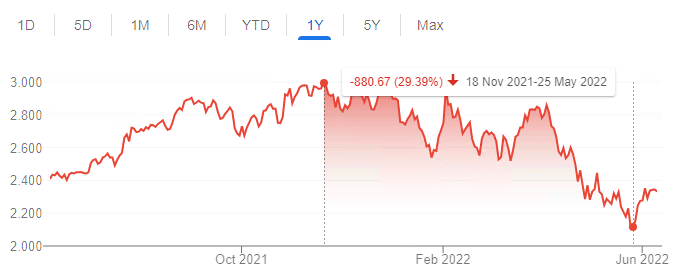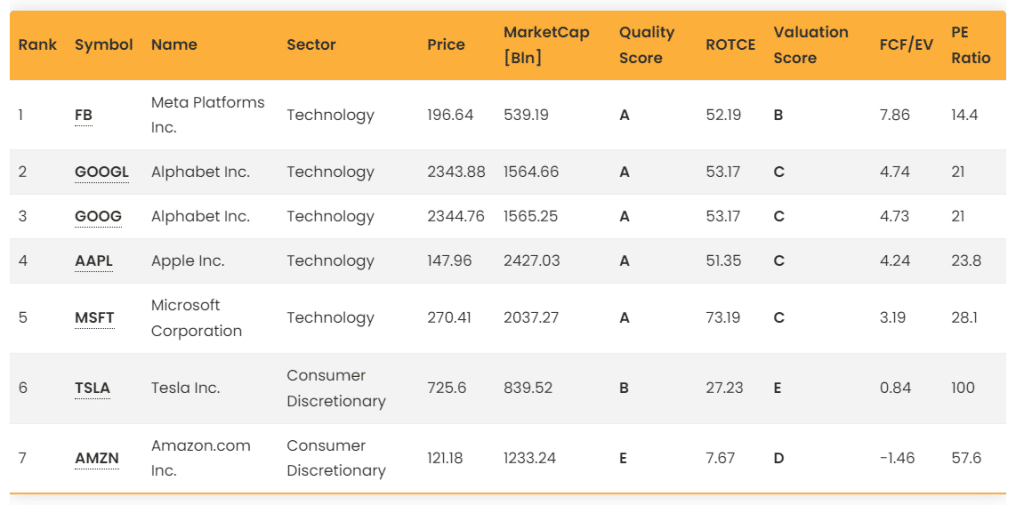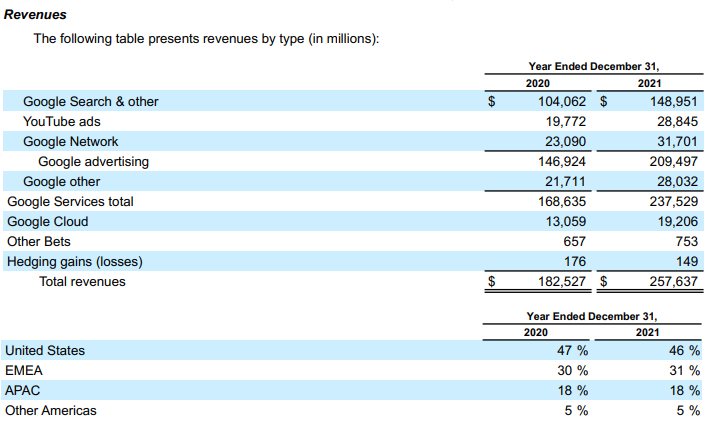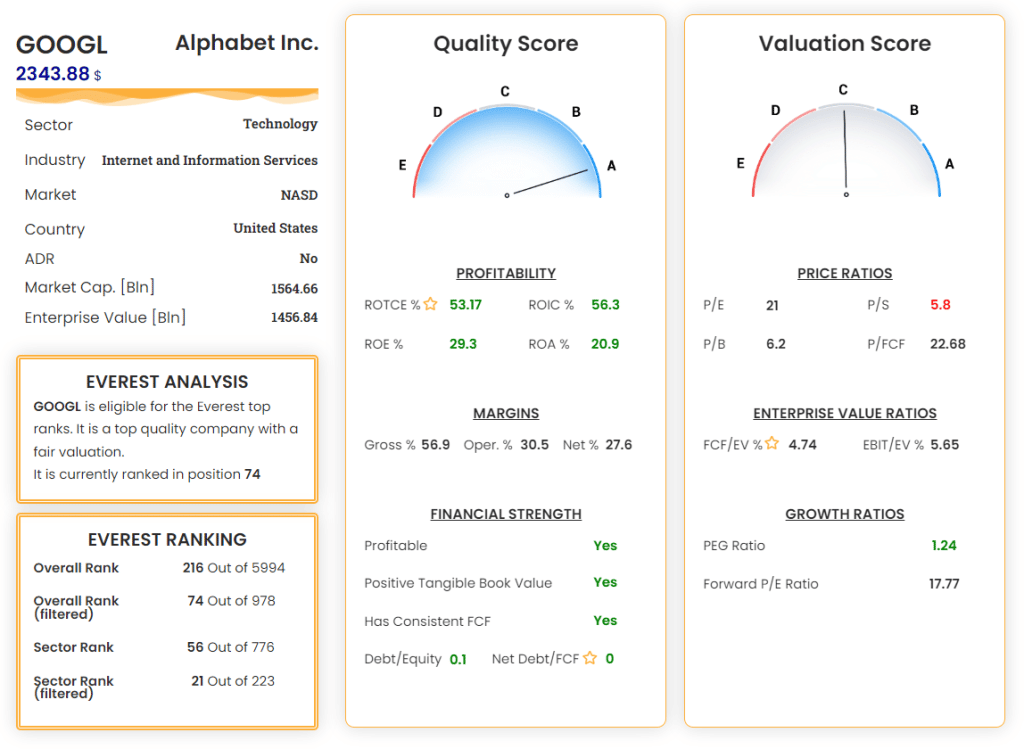- Alphabet, the parent company of extremely important services such as Google, Youtube and Android, has recently lost almost 30 percent from the highs recorded at the end of last year, due to a general market decline and fears about slowing growth in the online advertising sector.
- The Everest Formula now recognizes it (along with Meta) as the best of the U.S. Mega-Caps available on the market.
- In this article we are going to analyze the stock, both using the most important indicators of the Everest Analyser and by calculating the intrinsic value of the stock with a Discounted Cash Flow model.
Are you interested in finding the best value stocks in each sector on your own? Premium members can use the Everest Screener to get the most valuable companies to invest in for each sector, everyday. Join now!
Introduction
Going on the Everest Screener to search for the best Mega Caps (i.e., companies with a capitalization greater than $500 billion) we find two companies that few people in the world have never heard of: Meta (Facebook’s parent company) on which we recently did an in-depth analysis of, and Alphabet, a company known to most as Google.
In this article we will examine the strengths of the company that have led it to be among the most important companies in the world; also we will assess the risks involved in investing in it now, and will calculate a valuation that is turning the first two points into numbers and a plausible intrinsic value.
Alphabet – Overview and current situation
Google has been one of the most important companies in the technology sector over the past 20 years, with annual revenues that have recently passed 250 billion dollars and an average annual growth rate of about 20 percent per year over the past 10 years, that doesn’t seem to slowdown. More than 90% of the revenue come from advertising delivered on the platforms, largely on the Google search engine but also on YouTube and partner sites. In addition to advertising, Google is expanding its revenues in other areas, such as hardware sales (Fitbit), cloud computing (Google Cloud), subscriptions (Youtube Premium), and other new investments that Google calls “other bets” (one among them Waymo, an autonomous vehicle driving project).
How is the company doing? Since the Google IPO in 2004, the company has executed phenomenally well, making big bets that have helped it dominate industries, such as Search, mobile operating systems (Android), and internet videos (YouTube). Short-form videos are the craze currently led by TikTok, but YouTube is holding up well, averaging over 30 billion daily views, which is up four times as much as a year ago.
What is Alphabet focusing on now? The company is making great strides in the areas of artificial intelligence, the cloud, and multiple search. These efforts are possible because of the company’s prodigious R&D spending, which has been nearly $30 billion annually for the past two years, and $100 billion over the past five years.

Why has Alphabet fallen 30 percent in the past months? Compounded by a general bearish market, the stock has lost ground since the end of last year. The current macroeconomic scenario of possible recession and hyperinflation points to a possible slowdown in advertising demand, a dancing dollar relative to other currencies, and an inevitable slowdown in sales from the huge growth it has had in the past 2 years, due in large part to the pandemic that forced people home.
Investment thesis
Alphabet has built truly world-class advertising technologies for its customers to run their digital marketing businesses. Google’s competitive advantages continue to grow through the collection of data, allowing the company to provide the right ad at the right time. Added to this is the synergy between services in its portfolio:
- Google Services: generates revenues primarily though selling ads on Google Search, YouTube, and Google Network partners’ properties.
- Google Play: thanks to the spread of Android on phones, Alphabet generates revenue from the sale of apps and in-app purchases in the Google Play store.
- Hardware sales: Alphabet earns revenue from sales of Fitbit wearable devices, Google Nest home products, Pixel phones, and other devices.
- YouTube: Alphabet has made great progress on YouTube, generating revenues from both YouTube Premium and YouTube Tv subscriptions.
- Google Cloud: These services allow businesses with features like data migration, machine learning, and services such as Google Workspace.
Risks in investing in Google
Alphabet’s management expects several obstacles to slow growth if not decrease earnings in the coming months, including:
- Possible slowdown on advertising demand, due to the inflationary environment that causes spending reviews and less money circulation.
- Foreign exchange rate, with the strong dollar being an headwind due to worldwide sales as opposed to research and development spending that is primarily U.S.-based
- Growth in the past two years has been enhanced by the pandemic, which has increased the use of Alphabet’s services. 2022 will inevitably see a slowdown in growth.
- Possible legislative hurdles: Both the U.S. Senate and the European Community have initiated tough new legislative efforts to counter Alphabet’s “unfair market dominance.”
Let’s make a quantitative and qualitative valuation of the stock, considering the strengths and risks mentioned so far.
A look at Alphabet using the Everest Analyzer
Quality Score: There’s no surprise that Google is one of the best companies from a quality perspective. Management has always been able to produce high profits with few assets, without ever relying to any form of debt and with impressive margins, symptoms of a huge and permanent competitive advantage. In fact, no competitor has ever been able to enter the search engine business since the Google establishment. Alphabet rightly gets an A as a score on quality.
Valuation Score: Although Everest Analyzer assigns C as its evaluation score (i.e., fairly valued), the tech sector in which the company navigates usually has higher multiples than Alphabet right now. In fact, a PE ratio of 21 can be considered low compared to the company’s past and future growth. Confirming this, the PEG ratio (which also considers future growth) indicates a good time to buy the stock. We would have preferred to see a price/sales ratio below 5 to be convinced to buy, but all in all the quantitative valuation of the company is satisfactory and makes the stock worthy of a deeper qualitative analysis to estimate its intrinsic value.
Evaluation of Alphabet through Discounted Cash Flow
We proceed to analyze Alphabet through a DCF model. Here are the assumptions we made considering the company’s strengths and weaknesses:
- Future Revenue Growth: Taking into account all the possible difficulties that the company may have in the near future, we assumed a growth over the next 5 years of 14%, and then gradually reducing it until approaching a perpetual growth rate of 3%/year from year 10, in line with the growth of the global economy. In our estimate, we also considered the fact that the larger a company is, the more difficult it will keep up the growth it had in previous years. However, we believe that the current competitive advantage and the new areas Google is entering will provide lifeblood for future growth.
- Future operating margins: our assumption is that Google’s competitive advantage will not be affected in the foreseeable future, and that margins will remain stable and similar to current margins, slightly reducing it to 28% to account for possible legislative adversities.
- Future taxation and sales-to-capital ratio: We assume that Alphabet will maintain an average effective tax rate of 18% and a sales-to-capital ratio of 1.7, in line with its recent past.
- Discount rate: we choose to discount the future cash flow with the Weighted Average Cost of Capital (WACC), that is the most reliable way to value a company, because it takes into account its risks and the overall market outlook. We computed a WACC of 8.5% for Alphabet.
With these input we are able to estimate year by year the expected free cash flow in hand of the company, from year 1 to year 10, in which we assume to sell the stock. Summing up all these discounted FCF, and subtracting debt and adding current cash, we obtain an intrinsic value for each share of $2951.
Given our calculations and the current price of $2343, the stock seems 21% undervalued. Here you can download the template used. You can modify the assumptions and extract your own intrinsic value.
Conclusions
Alphabet is one of the best companies in the market, and after the recent decline in its price mainly due to macroeconomic factors, it is also a great stock to hold in your portfolio. The Everest Formula has recognized this and ranked Alphabet as the second best investment among Mega Caps. The Everest Formula indeed is not only a successful investing strategy, but also a powerful algorithm that can be used to seek out value stocks in any sector and any market condition.
So, what are you waiting for? Join our community!





